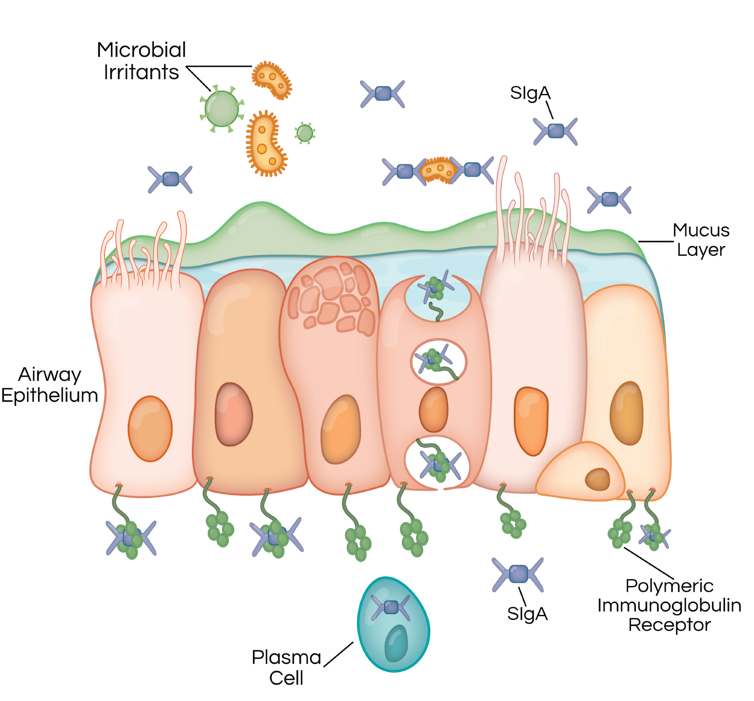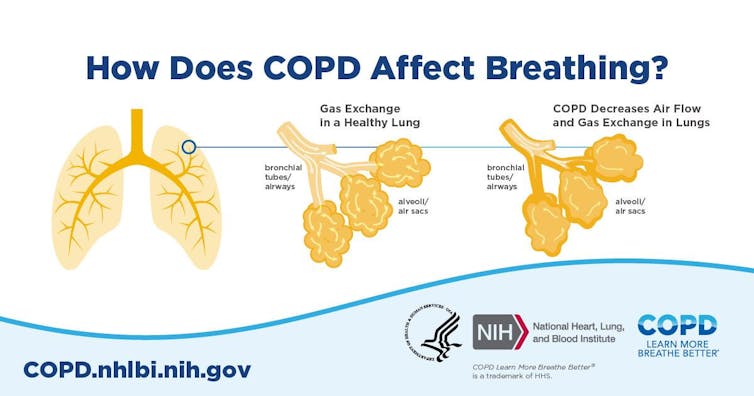Bradley Richmond, Vanderbilt University
Smoking is the most typical reason behind continual obstructive pulmonary illness, an typically deadly respiratory situation that afflicts millions of Americans. But for a lot of sufferers dwelling with COPD, stopping smoking isn’t the tip of the battle.
Cigarette smoke is a fancy combination of gases, chemical substances and even micro organism. When it enters the lungs, it generates an inflammatory response very similar to pneumonia.
Inflammatory cells usually clear from the lungs when an an infection ends or a affected person quits smoking, however in sufferers with COPD, these cells might persist for years. Destructive enzymes produced by these cells – supposed to destroy micro organism – trigger progressive lung harm and respiratory failure attribute of COPD.
It’s been a thriller why these cells proceed triggering irritation in the lungs after individuals cease smoking. Now, new research indicates a defect in the immune system induced by cigarette smoke is to blame. Cigarette smoke reprograms the cells lining the airways, making the lungs of COPD sufferers who’ve stop smoking extra prone to bacterial invasion.
Good fences make good neighbors
The lungs are constantly bombarded by inhaled micro organism and different irritants. At the identical time, they’re tasked with getting oxygen into the bloodstream, in order that they can’t have an impermeable bodily barrier like pores and skin.
To resolve this dilemma, the lungs have developed a multi-pronged protection system. A key element of this method is an antibody known as secretory IgA. These antibodies latch on to micro organism to forestall them from invading the lungs. Secretory IgA doesn’t instantly kill microbes, but it surely prevents them from triggering a harmful immune response earlier than they can be cleared by different mechanisms.

In sufferers with COPD, decrease ranges of the polymeric immunoglobulin receptor and secretory IgA allow bacteria easier access to the airway surface, triggering an inflammatory response that persists after the affected person quits smoking.
Mice which have been genetically manipulated to lack secretory IgA also develop inflammation and a pattern of lung damage resembling sufferers with COPD. Antibiotics can forestall them from creating lung illness, suggesting micro organism trigger continued irritation after smoking ends.
The double-edged sword of anti-inflammatories
Since irritation is central to COPD, it is sensible that anti-inflammatory therapies is perhaps helpful. However, sufferers with COPD are additionally prone to lung infections, and anti-inflammatories run the danger of deactivating the physique’s pure defenses in opposition to an infection. The menace is greater than theoretical: A clinical trial learning an anti-inflammatory drug known as rituximab was stopped early due to an elevated fee of pulmonary infections.
Many antibiotics even have critical negative effects when taken chronically, and extended use would possibly encourage development of micro organism resistant to these medication.
A brand new goal for treating COPD?
While learning mice missing secretory IgA, our analysis group at Vanderbilt University Medical Center and colleagues on the University of Florida not too long ago discovered these mice have elevated numbers of a comparatively unusual kind of cell known as monocyte-derived dendritic cells, or moDCs, in the lungs.
Dendritic cells don’t instantly destroy micro organism, however they ring the alarm {that a} bacterial an infection is brewing and coordinate the next immune response. Unlike typical dendritic cells, moDCs start their lives as a special cell kind, known as a monocyte. But when continual irritation units in, they can grow to be a kind of dendritic cell.
We confirmed that in mice genetically engineered to lack secretory IgA, moDCs activate T lymphocytes – white blood cells that struggle off viruses and can destroy cells in the method – and people T lymphocytes in flip harm the lungs. These information implied that moDCs may also coordinate a pathologic immune response in sufferers with COPD who additionally lack secretory IgA in the airways.
Because moDCs weren’t identified to exist in human lungs, we used a cutting-edge technique called mass cytometry to detect them. It permits us to distinguish moDCs from different cell sorts that seem very comparable below a microscope.
Like secretory IgA-deficient mice, we discovered that human COPD sufferers missing secretory IgA had elevated numbers of moDCs in their lungs. Together, these information recommend that lack of secretory IgA makes the airways extra prone to bacterial invasion, which prompts moDCs to drive ongoing lung irritation. Therefore, concentrating on moDCs by medical remedies would possibly block irritation and lung harm in sufferers with COPD.
New medication are urgently wanted for COPD
There are nonetheless many questions to reply, together with how greatest to goal moDCs. It additionally stays to be seen whether or not such a technique would compromise the power of COPD sufferers to defend in opposition to an infection.
However, for a illness as frequent and debilitating as COPD, potential new drug targets come as a breath of contemporary air.
[Deep knowledge, daily. Sign up for The Conversation’s newsletter.]
COPD is the fourth leading cause of death in the U.S. and the third leading cause of death worldwide. While many medication can be found to lower signs and hospitalization charges in sufferers with COPD, none has been confirmed to extend life.
Most sufferers with COPD don’t die from it, but those who live with COPD endure from continual breathlessness which negatively impacts their high quality of life. The burden of COPD is felt not simply by particular person sufferers, however by households, workplaces and economies.
Though cigarette smoking charges are declining in the United States, they’re increasing in many other countries, making COPD a worldwide well being difficulty.
Bradley Richmond, Assistant Professor of Medicine, Vanderbilt University
This article is republished from The Conversation below a Creative Commons license. Read the original article.







